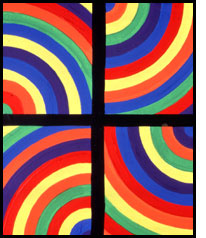The conceptual art Sol LeWitt helped
spawn three decades ago is a
particularly American kind, preoccupied
with plain things like lines on walls,
cubes in space. He countered the heroic
angst of Jackson Pollock in the lowest
key, with simple maxims such as “The idea
becomes a machine that makes the art”
and “One thing always leads to
another.” But LeWitt is still making
people anxious.
During a question-and-answer period at
the San Francisco Museum of Modern Art
on the opening day of his second
traveling retrospective (the first was
in 1978 and started off at the Museum of
Modern Art in New York), audience
members worried about one thing in the
guise of many. Most of LeWitt’s
two-dimensional works appear directly on
the walls, instead of on canvas or
paper. When he has to transfer a “wall
drawing” from one venue and size of wall
to another, how does he know, someone
asked, if he’s preserved his original
idea? (There are no originals, he
explained, only variations.) Was the
artist who draws and writes recipes for
pieces that others execute ever taken
aback by the result? (“I think of it
conceptually and perceptually. So I’m
always surprised and never surprised.”)
And when he’s dead and can’t do anything
about it, how will he feel then
about his abdication of control?
LeWitt surfaced in their questions as
the engineer of a “Modern Times” art
machine that dements its own
once-innocent ideas. The crowd was
overtaken by the very anxiety in the art
itself. “I’m trapped in my own premise
that from the instructions, the work can
be made,” he said. This trap is the
foundation for LeWitt’s absurd comedy:
It’s Beckett with blocks and paint.
LeWitt embeds the instructions for many
of his pieces in their titles. The title
of the faint pencil piece “Wall Drawing
#73” (1971) continues, “Lines, not
straight not touching, drawn at random,
uniformly dispersed with maximum
density, covering the entire surface of
the wall.” The tag’s cheerful confidence
is perfectly matched by its total
failure to prepare the viewer for the
drawing, which resembles a topographical
map of a landscape without any
landmarks. From its description (“Lines
not short, not straight, crossing and
touching, drawn at random using four
colors”), you wouldn’t know that “Wall
Drawing #65” (1971) looks like a tangly
expanse of dark hair — a mess.
In the first 20 years of his career,
represented by half of the
retrospective, LeWitt moved with
mechanical hope from one fit of neatness
to another until he’d filled thousands
of spaces with piles of skeletal cubes;
books of photographed sunsets, walls of
bricks, his apartment’s complete
contents, all arranged in neat grids;
and pencil scratchings and crayon
markings of arcs, lines, circles,
squares and their manifold combinations
and permutations. The works are proofs
that, once unspooled, simple ideas turn
into chaos and complicated plans never
amount to much. They offer themselves as
pointedly inadequate rest stops on a
one-way road to disorder or to banality.
The pieces aren’t tragicomic
individually. As a serial artist whose
whole premise is never to summarize,
exemplify or represent, but to take an
idea straight through to its pointless
end without skipping a step and then
move on to a corollary plan, LeWitt
needs a big show to make himself clear.
This one is too small. Particularly as
it moves into the second 20 years, “Sol
LeWitt: A Retrospective” inserts too
many ellipses in the artist’s exhaustive
progress.
Or maybe LeWitt himself became
elliptical. For 20 years, it was
important to him that his discrete
elements (arcs, cubes, etc.) be boring;
they weren’t the story, just its tools.
But in the ’80s, he inexplicably began
to paint enormous, isolated cubes,
spheres and pyramids in rich Renaissance
hues. The Platonic forms float on the
wall in an invocation — blasphemous for
a small “c” conceptual artist — of
three-dimensional space. After years of
insisting on taking his materials for
granted, LeWitt seemed suddenly struck
by a reverence for them that bordered on
the sentimental.
An artist doesn’t have to adhere to the
rules he establishes for himself early
in his career. He can do whatever he
wants. But LeWitt’s art is its
rules to a large extent; our pleasure in
the uncomfortable condition that his
proliferating series enacts has always
depended on being absorbed by the plans,
just as much as by their look. Moving
from systematic explorations of first
one element (grids, let’s say) and then
another (arcs) and another (squares) and
another (lines), viewers play out the
formulas on their fingers. You can hear
them before “Incomplete Open Cubes”
(1974) loudly working the math behind
the grid arrangement. Getting churned
through the art’s machine, mirroring its
monkey mind, you eventually took the
basic absurdist premise that animated
LeWitt, again and again, as necessary
and your own. When he gave it up for
something else, it was hard not to feel
duped.
But in the past few years, he has begun
to return to the old story, this time as
commentary. The pieces used to just act
goofy; now, filled with thick stripes in
bold colors, they look goofy. One 1999
wall drawing even reminds us what goofy
means in the LeWitt lexicon. “Arcs in
Four Directions” consists of four sets
of concentric, brilliantly colored arcs,
divided by two perpendicular black
bands: a bungled painting of a target,
spot-on in its bright futility.
“Sol LeWitt: A Retrospective” remains at
SFMOMA
through May 21, then travels to the
Museum of Contemporary Art in Chicago
(July 22-Oct. 22); the Whitney
Museum of American Art in New York (Nov.
30-Feb. 25) and European venues, to be
determined.

